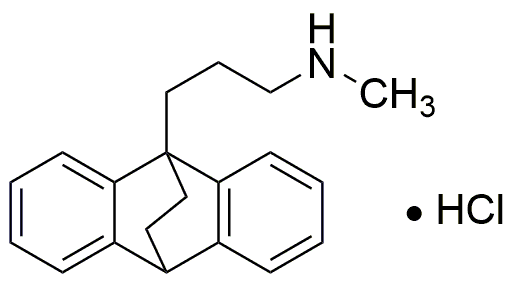Maprotiline hydrochloride is widely utilized in research focused on:
- Antidepressant Therapy: Commonly prescribed for major depressive disorders, it helps improve mood and emotional well-being, making it a vital option in psychiatric care.
- Psychiatric Research: Used in clinical studies to understand the mechanisms of depression and anxiety, aiding researchers in developing new therapeutic strategies.
- Pharmaceutical Development: Serves as a reference compound in the formulation of new medications, particularly in the study of tetracyclic antidepressants.
- Neuroscience Studies: Employed in animal models to investigate the effects of antidepressants on brain chemistry, providing insights into neuropharmacology.
- Comparative Effectiveness Research: Used to compare the efficacy of various antidepressants, helping healthcare providers make informed treatment decisions.
Información general
Propiedades
Seguridad y normativas
Aplicaciones
Maprotiline hydrochloride is widely utilized in research focused on:
- Antidepressant Therapy: Commonly prescribed for major depressive disorders, it helps improve mood and emotional well-being, making it a vital option in psychiatric care.
- Psychiatric Research: Used in clinical studies to understand the mechanisms of depression and anxiety, aiding researchers in developing new therapeutic strategies.
- Pharmaceutical Development: Serves as a reference compound in the formulation of new medications, particularly in the study of tetracyclic antidepressants.
- Neuroscience Studies: Employed in animal models to investigate the effects of antidepressants on brain chemistry, providing insights into neuropharmacology.
- Comparative Effectiveness Research: Used to compare the efficacy of various antidepressants, helping healthcare providers make informed treatment decisions.
Documentos
Hojas de datos de seguridad (HDS)
La SDS proporciona información de seguridad completa sobre la manipulación, el almacenamiento y la eliminación del producto.
Especificación del producto (PS)
La PS proporciona un desglose completo de las propiedades del producto, incluida la composición química, el estado físico, la pureza y los requisitos de almacenamiento. También detalla los rangos de calidad aceptables y las aplicaciones previstas del producto.
Certificados de análisis (COA)
Busque certificados de análisis (COA) ingresando el número de lote del producto. Los números de lote y de partida se pueden encontrar en la etiqueta de un producto después de las palabras "Lote" o "Lote".
Número de catálogo
Número de lote/lote
Certificados de origen (COO)
Este certificado de origen confirma el país en el que se fabricó el producto y también detalla los materiales y componentes utilizados en él y si se deriva de fuentes naturales, sintéticas u otras fuentes específicas. Este certificado puede ser necesario para cumplir con las normativas aduaneras, comerciales y regulatorias.
Número de catálogo
Número de lote/lote
Hojas de datos de seguridad (HDS)
La SDS proporciona información de seguridad completa sobre la manipulación, el almacenamiento y la eliminación del producto.
DownloadEspecificación del producto (PS)
La PS proporciona un desglose completo de las propiedades del producto, incluida la composición química, el estado físico, la pureza y los requisitos de almacenamiento. También detalla los rangos de calidad aceptables y las aplicaciones previstas del producto.
DownloadCertificados de análisis (COA)
Busque certificados de análisis (COA) ingresando el número de lote del producto. Los números de lote y de partida se pueden encontrar en la etiqueta de un producto después de las palabras "Lote" o "Lote".
Número de catálogo
Número de lote/lote
Certificados de origen (COO)
Este certificado de origen confirma el país en el que se fabricó el producto y también detalla los materiales y componentes utilizados en él y si se deriva de fuentes naturales, sintéticas u otras fuentes específicas. Este certificado puede ser necesario para cumplir con las normativas aduaneras, comerciales y regulatorias.


